Post-Fire Restoration Plan for Sustainable Forest Management in South Korea
Abstract
:1. Introduction
2. Formation of Modern Korean Forests
3. Modern Korean Forest Fires
4. Review on the Current Post-Fire Forest Restoration Planning
5. Executing Restoration
5.1. Urgent Restoration
5.2. Long-Term Restoration
6. Conclusions and Recommendations
Acknowledgments
Author Contributions
Conflicts of Interest
References
- Doblas-Miranda, E.; Martínez-Vilalta, J.; Lloret, F.; Álvarez, A.; Ávila, A.; Bonet, F.J.; Brotons, L.; Castro, J.; Curiel Yuste, J.; Díaz, M.; et al. Reassessing global change research priorities in mediterranean terrestrial ecosystems: How far have we come and where do we go from here? Glob. Ecol. Biogeogr. 2015, 24, 25–43. [Google Scholar] [CrossRef]
- Littell, J.S.; McKenzie, D.; Peterson, D.L.; Westerling, A.L. Climate and wildfire area burned in western U.S. ecoprovinces, 1916–2003. Ecol. Appl. 2009, 19, 1003–1021. [Google Scholar] [CrossRef] [PubMed]
- Williams, A.P.; Abatzoglou, J.T. Recent advances and remaining uncertainties in resolving past and future climate effects on global fire activity. Curr. Clim. Chang. Rep. 2016, 2, 1–14. [Google Scholar] [CrossRef]
- Ahn, Y.S.; Ryu, S.R.; Lim, J.; Lee, C.H.; Shin, J.H.; Choi, W.I.; Lee, B.; Jeong, J.H.; An, K.W.; Seo, J.I. Effects of forest fires on forest ecosystems in eastern coastal areas of Korea and an overview of restoration projects. Landsc. Ecol. Eng. 2014, 10, 229–237. [Google Scholar] [CrossRef]
- Dennison, P.; Brewer, S.; Arnold, J.; Moritz, M. Large wildfire trends in the western United States, 1984–2011. Geophys. Res. Lett. 2014, 41, 2928–2933. [Google Scholar] [CrossRef]
- Westerling, A.L. Increasing western US forest wildfire activity: Sensitivity to changes in the timing of spring. Philos. Trans. R. Soc. B 2016, 371, 20150178. [Google Scholar] [CrossRef] [PubMed]
- Westerling, A.L.; Hidalgo, H.G.; Cayan, D.R.; Swetnam, T.W. Warming and earlier spring increase western U.S. forest wildfire activity. Science 2006, 313, 940–943. [Google Scholar] [CrossRef] [PubMed]
- Kasischke, E.S.; Turetsky, M.R. Recent changes in the fire regime across the North American boreal region-Spatial and temporal patterns of burning across Canada and Alaska. Geophys. Res. Lett. 2006, 33, L09703. [Google Scholar] [CrossRef]
- Kelly, R.; Chipmanb, M.L.; Higuerac, P.E.; Stefanovad, I.; Brubakere, L.B.; Hu, F.S. Recent burning of boreal forests exceeds fire regime limits of the past 10,000 years. Proc. Natl. Acad. Sci. USA 2011, 110, 13055–13060. [Google Scholar] [CrossRef] [PubMed]
- Batllori, E.; Parisien, M.A.; Krawchuk, M.A.; Moritz, M.A. Climate change-induced shifts in fire for Mediterranean ecosystems. Glob. Ecol. Biogeogr. 2013, 22, 1118–1129. [Google Scholar] [CrossRef]
- Lenihan, J.M.; Drapek, R.; Bachelet, D.; Neilson, R.P. Climate change effects on vegetation distribution, carbon, and fire in California. Ecol. Appl. 2003, 13, 1667–1681. [Google Scholar] [CrossRef]
- St.John, T.V.; Rundel, P.W. The role of fire as a mineralizing agent in a Sierran coniferous forest. Oecologia 1976, 25, 35–45. [Google Scholar] [CrossRef] [PubMed]
- Fulé, P.Z.; Covington, W.W.; Moore, M.M. Determining reference conditions for ecosystem management of southwestern ponderosa pine forests. Ecol. Appl. 1997, 7, 895–908. [Google Scholar] [CrossRef]
- Allen, C.D.; Savage, M.; Falk, D.A.; Suckling, K.F.; Swetnam, T.W.; Schulke, T.; Stacey, P.B.; Morgan, P.; Hoffman, M.; Klingel, J.T. Ecological restoration of southwestern ponderosa pine ecosystems: A broad perspective. Ecol. Appl. 2002, 12, 1418–1433. [Google Scholar] [CrossRef]
- Covington, W.W.; Moore, M.M. Post-settlement changes in natural fire regimes and forest structure: Ecological restoration of old-growth ponderosa pine forests. J. Sustain. For. 1994, 2, 153–181. [Google Scholar] [CrossRef]
- Hunter, M.E.; Omi, P.N.; Martinson, E.J.; Chong, G.W. Establishment of non- native species after wildfires: Effects of fuel treatments, abiotic and biotic factors, and post-fire grass seeding treatments. Int. J. Wildland Fire 2006, 15, 271–281. [Google Scholar] [CrossRef]
- Keeley, J.E. Fire management impacts on invasive plants in the western United States. Conserv. Biol. 2006, 20, 375–384. [Google Scholar] [CrossRef] [PubMed]
- Youn, Y.C. Assessment of social coasts of forest fire: Case of forest fire of spring 2000 in the east coast area of South Korea. Korean For. Econ. Soc. 2000, 8, 72–81, (In Korean with English abstract). [Google Scholar]
- Ryu, S.R.; Chen, J.; Zheng, D.; Bresee, M.K.; Crow, T.R. Simulating the effects of prescribed burning on fuel loading and timber production (EcoFL) in managed northern Wisconsin forests. Ecol. Model. 2006, 196, 395–406. [Google Scholar] [CrossRef]
- Lim, J.; Lee, Y.; Jeong, J.; Lee, M.B. Post-Fire restoration: To Establish a Healthy and Sustainable Forest Ecosystem; Ukgo Press: Seoul, Korea, 2010; pp. 1–60. [Google Scholar]
- Allingham, S.M.; Harvey, M. Effects of different fire regimes on amphibian communities in the Nyika National Park, Malawi. Curr. Herpetol. 2013, 32, 1–8. [Google Scholar] [CrossRef]
- Bury, R.B. Wildfire, fuel reduction, and herpetofaunas across diverse landscape mosaics in northwestern forests. Conserv. Biol. 2004, 18, 968–975. [Google Scholar] [CrossRef]
- Cano, P.D.; Leynaud, G.C. Effects of fire and cattle grazing on amphibians and lizards in northeastern Argentina (Humid Chaco). Eur. J. Wildl. Res. 2010, 56, 411–420. [Google Scholar] [CrossRef]
- Groves, C.R.; Steenhof, K. Responses of small mammals and vegetation to wildfire in shadscale communities of Southwestern Idaho. Northwest Sci. 1988, 62, 205–210. [Google Scholar]
- Kelly, L.T.; Nimmo, D.G.; Spence-Bailey, L.M.; Taylor, R.S.; Watson, S.J.; Clarke, M.F.; Bennett, A.F. Managing fire mosaics for small mammal conservation: A landscape perspective. J. Appl. Ecol. 2012, 49, 412–421. [Google Scholar] [CrossRef]
- Law, B.S.; Dickman, C.R. The use of habitat mosaics by terrestrial vertebrate fauna: Implications for conservation and management. Biodivers. Conserv. 1998, 7, 323–333. [Google Scholar] [CrossRef]
- Korea Forest Service. Available online: http://www.forest.go.kr/ (accessed on 20 April 2017). (In Korean)
- Lim, J. Forest fire and meteorology of eastern Korea. Korean J. Agric. For. Meteorol. 2000, 2, 62–67, (In Korean with English abstract). [Google Scholar]
- Shin, J.H.; Lee, D.K. Strategies for restoration of forest ecosystems degraded by forest fire in Kangwon ecoregion of Korea. For. Ecol. Manag. 2004, 201, 43–56. [Google Scholar] [CrossRef]
- National Archives of Korea. In The Department of Agriculture, Forestry, Ocean and Fishery. Available online: http://www.archives.go.kr/ (accessed on 1 December 2016). (In Korean)
- Fontaine, J.B.; Donato, D.C.; Robinson, W.D.; Law, B.E.; Kauffman, J.B. Bird communities following high-severity fire: Response to single and repeat fires in a mixed-evergreen forest, Oregon, USA. For. Ecol. Manag. 2009, 257, 1496–1504. [Google Scholar] [CrossRef]
- Kim, C.; Lee, W.K.; Byun, J.K.; Kim, Y.K.; Jeong, J.H. Short-term effects of fire on soil properties in Pinus densiflora stands. J. For. Res. 1999, 4, 23–25. [Google Scholar] [CrossRef]
- Neary, D.G.; Klopatek, C.C.; DeBano, L.F.; Ffolliott, P.F. Fire effects on belowground sustainability: A review and synthesis. For. Ecol. Manag. 1999, 122, 51–71. [Google Scholar] [CrossRef]
- Korea Meteorological Administration. Available online: http://www.kma.go.kr/ (accessed on 1 December 2016). (In Korean)
- Lee, S.Y.; An, S.H. Comparative analysis of mortality in species of tree after surface forest fire. J. Korean Soc. Hazard Mitig. 2009, 9, 39–43, (In Korean with English abstract). [Google Scholar]
- Choung, Y.; Lee, B.C.; Cho, J.H.; Lee, K.S.; Jang, I.S.; Kim, S.H.; Hong, S.K.; Jung, H.C.; Choung, H.L. Forest responses to the large-scale east coast fires in Korea. Ecol. Res. 2004, 19, 43–54. [Google Scholar] [CrossRef]
- Lim, J.H; Kang, W.S.; Kwon, J.; Kim, J.; Cho, J.H.; Kwon, T.S.; Lee, Y.G.; Lee, W.S.; Kim, S.D.; Yoon, C.W.; et al. Monitoring Forest Ecosystem Changes Following Large Scale Fires and Developing Forest Restoration Treatments; National Institute of Forest Science: Seoul, Korea, 2016; pp. 1–191. (In Korean) [Google Scholar]
- Lim, J.H.; Kwon, J.; Choi, H.; Park, K.H.; Kang, W.S.; Shin, M.H.; Kim, J.; Kwon, T.S.; Ka, K.H.; Lee, Y.G.; et al. Forest Ecosystem Change since 1996 Wildfire in Korea; Korea Forest Research Institute: Seoul, Korea, 2015; pp. 1–12. [Google Scholar]
- Kang, Y.H.; Lim, J.; Shin, S.; Lee, M.B. A historical review on the forest fire prevention and establishment of fire line and firebreaks in Korea. J. Korean For. Soc. 2004, 93, 409–416, (In Korean with English abstract). [Google Scholar]
- Saha, S.; Kuhne, C.; Bauhus, J. Lessons learned from oak cluster planting trials in central Europe. Can. J. For. Res. 2017, 47, 139–148. [Google Scholar] [CrossRef]
- Saha, S.; Kuehne, C.; Bauhus, J. Tree Species Richness and Stand Productivity in Low-Density Cluster Plantings with Oaks (Quercus robur L. and Q. petraea (Mattuschka) Liebl.). Forests 2013, 4, 650–665. [Google Scholar] [CrossRef]
- Saha, S.; Kuehne, C.; Kohnle, U.; Brang, P.; Ehring, A.; Geisl, J.; Leder, B.; Muth, M.; Petersen, R.; Peter, J.; et al. Growth and quality of young oaks (Quercus robur and Quercus petraea) grown in cluster plantings in central Europe: A weighted meta-analysis. For. Ecol. Manag. 2012, 283, 106–118. [Google Scholar] [CrossRef]
- Keeley, J.E.; Pausas, J.G.; Rundel, P.W.; Bond, W.J.; Bradstock, R.A. Fire as an evolutionary pressure shaping plant traits. Trends Plant Sci. 2011, 16, 406–411. [Google Scholar] [CrossRef] [PubMed]
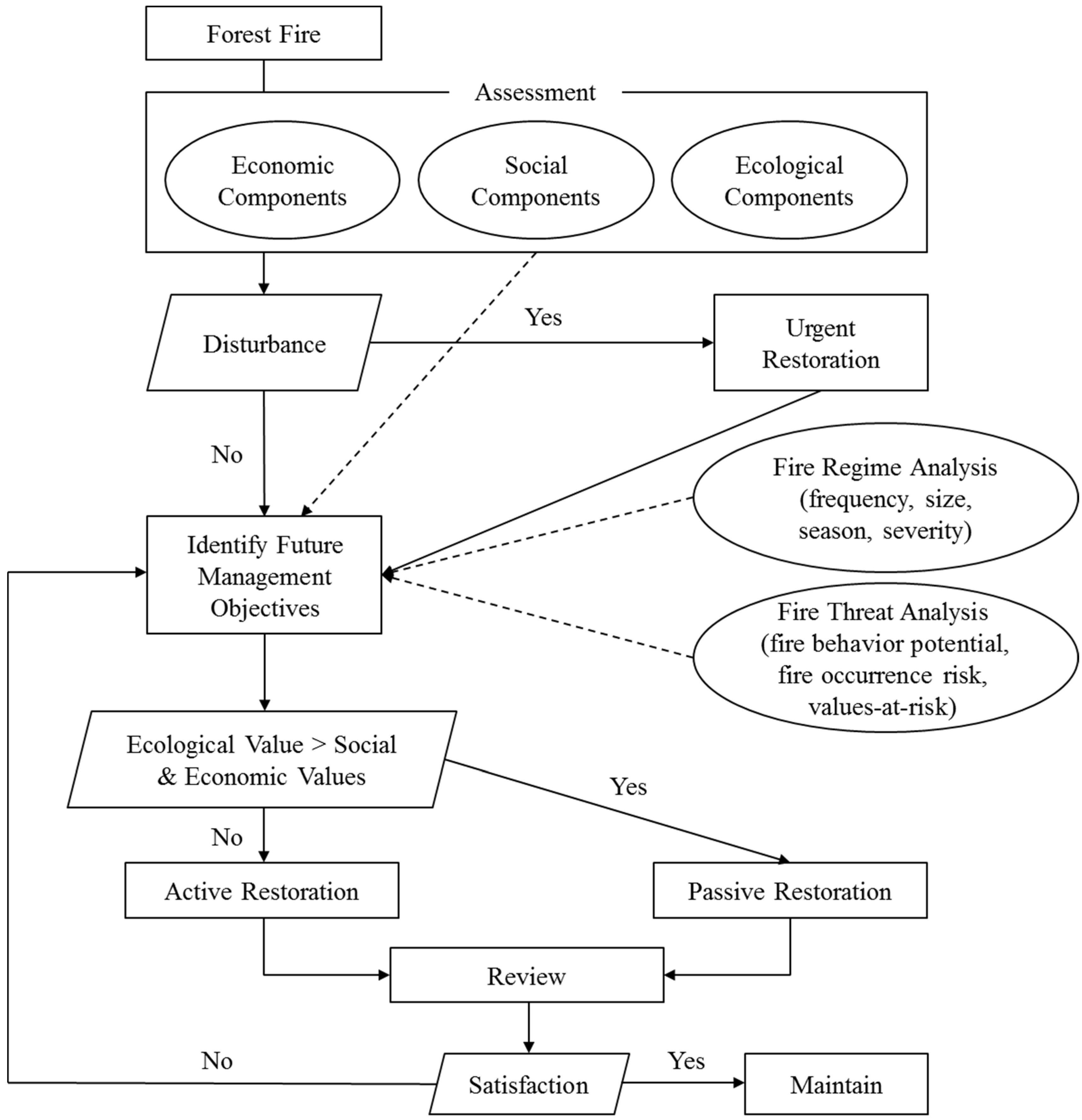
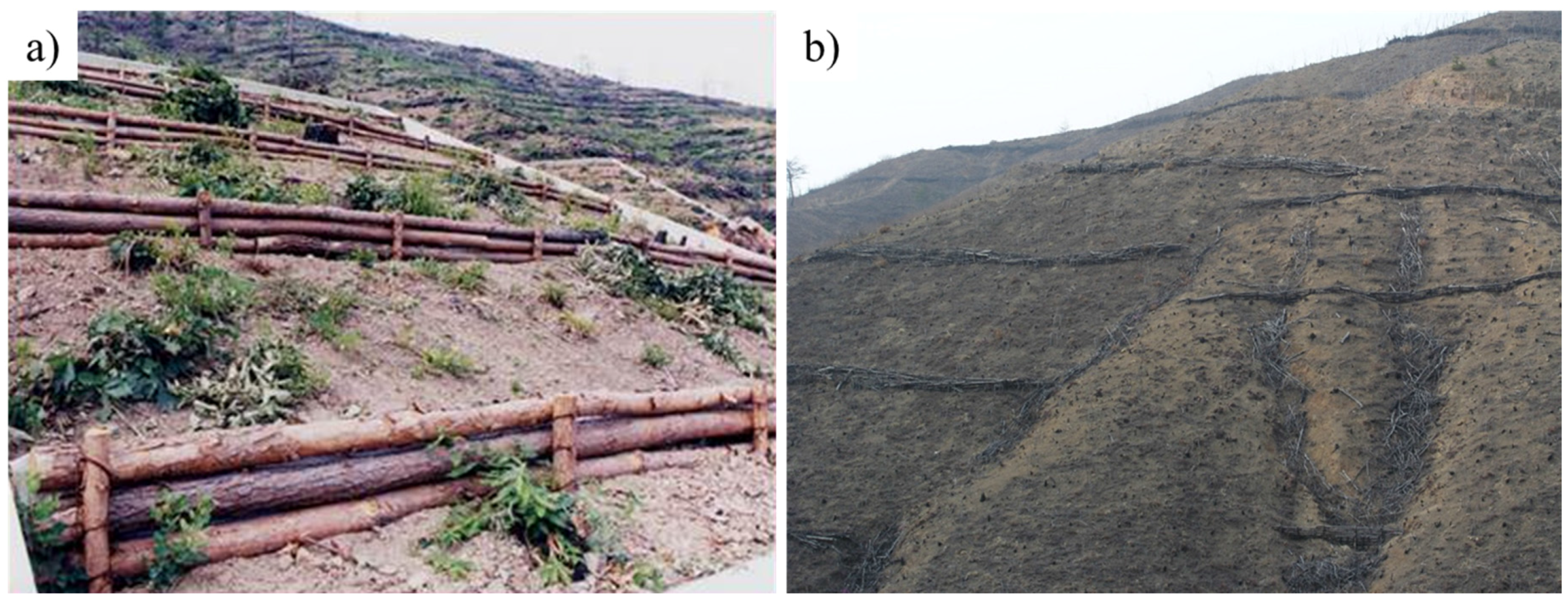
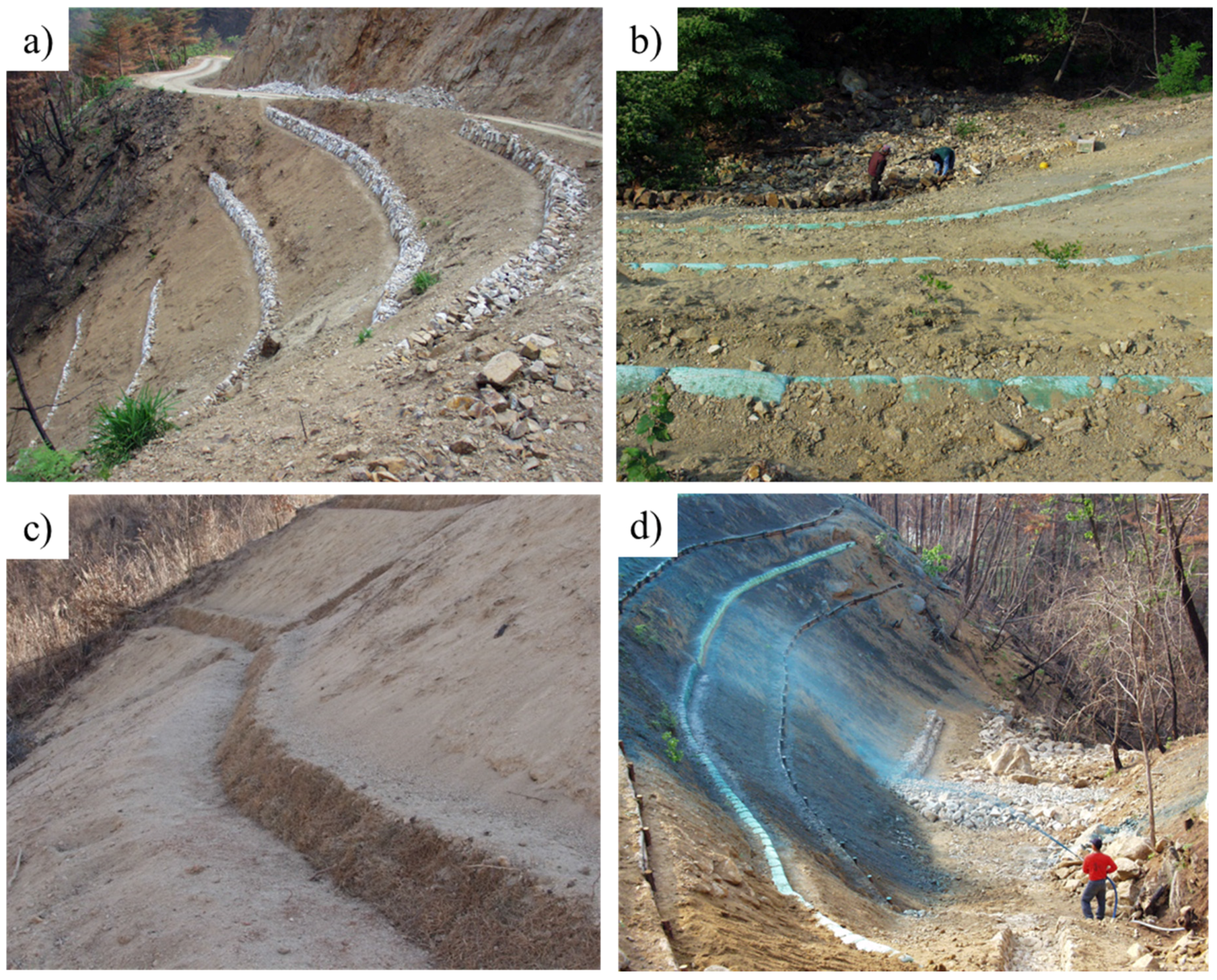

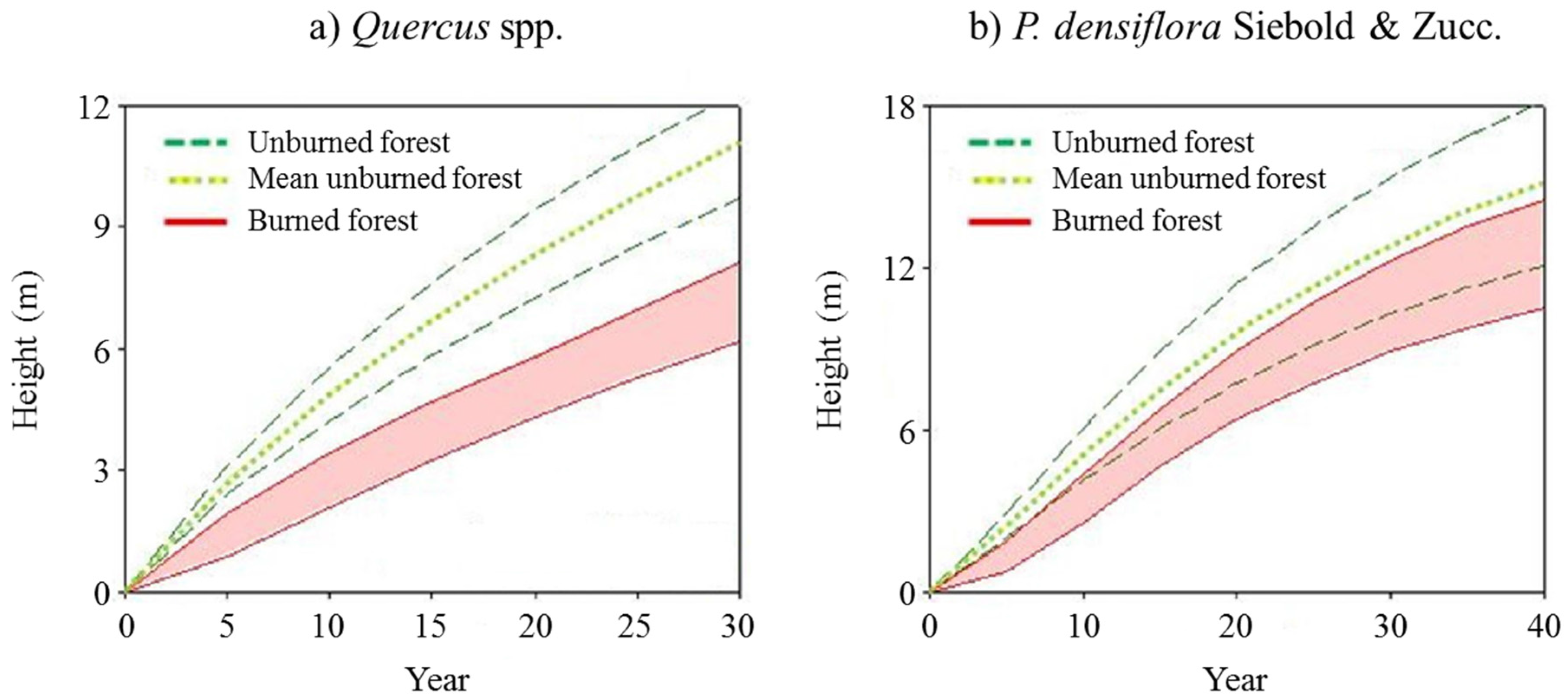
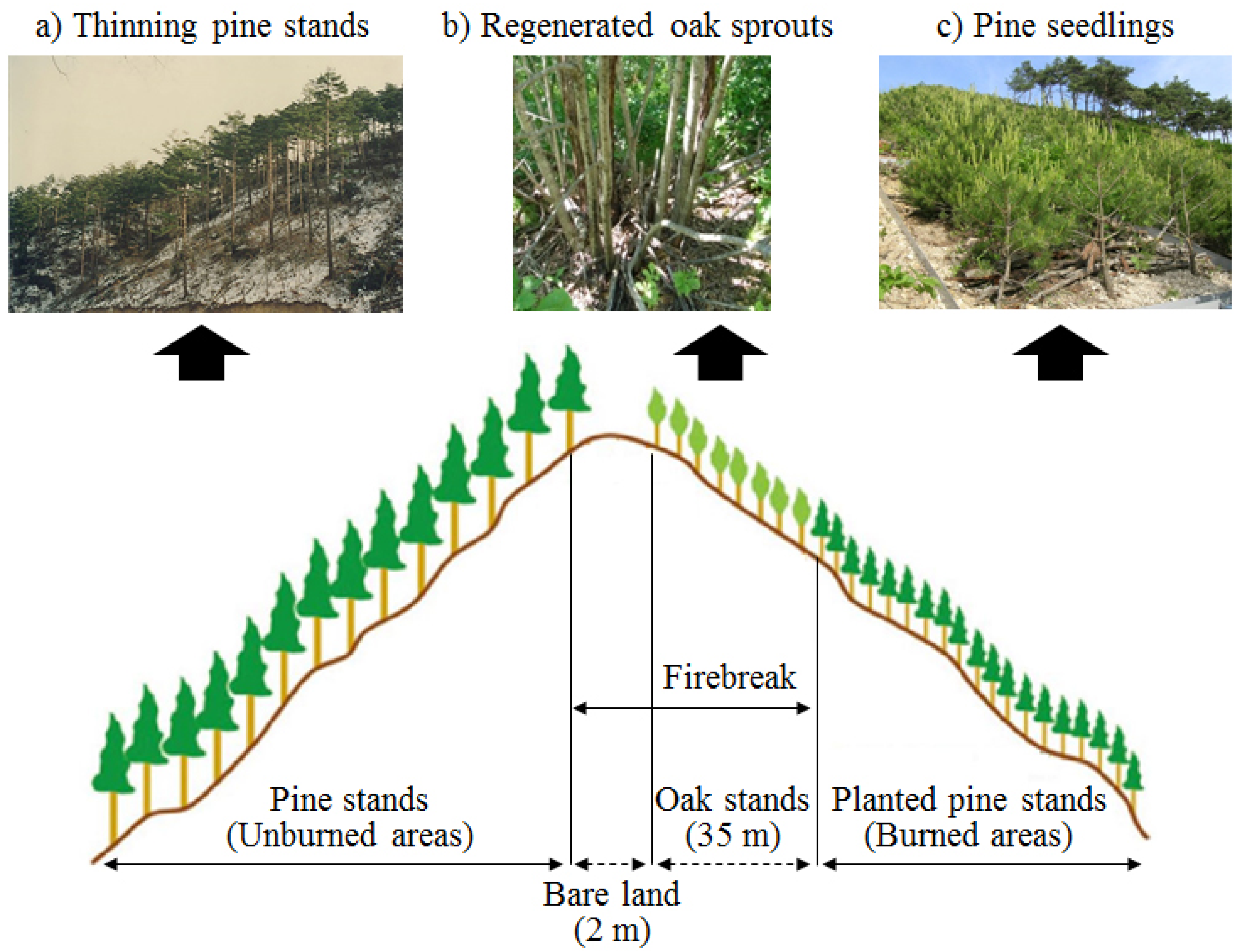
| Climate Zone | Main Species | Companion Species |
|---|---|---|
| Temperate | Pinus koraiensis Siebold & Zucc. | Pinus rigitaeda S.K.Hyun & Ahn |
| Larix kaempferi (Lamb.) Carrière | Fraxinus rhynchophylla Hance | |
| P. densiflora Siebold & Zucc. | Juglans mandshurica Maxim. | |
| Betula platyphylla var. japonica (Miq.) H.Hara | ||
| Quercus spp. | ||
| Liriodendron tulipifera L. | ||
| Sub-Tropical | Pinus thunbergii Parl. | Pinus taeda L. |
| Chamaecyparis obtuse (Siebold & Zucc.) Endl. | Cryptomeria japonica (L.f.) D.Don | |
| Liriodendron tulipifera L. | Quercus myrsinifolia Blume | |
| Machilus thunbergii Siebold & Zucc. |
| Climate Zone | Tree Species | Shrub Species |
|---|---|---|
| Temperate | Ginkgo biloba L. | Picrasma quassioides (D.Don) Benn. |
| Quercus variabilis Blume | Fraxinus sieboldiana Blume | |
| Quercus acutissima Carruth. | Sorbus commixta Hedl. | |
| Quercus dentata Thunb. | ||
| F. rhynchophylla Hance | ||
| Populus maximowiczii Henry | ||
| Sub-Tropical | Myrsinaefoliae | Viburnum awabuki K.Koch |
| Cinnamomum camphora (L.) J.Presl | Daphniphyllum macropodum Miq. | |
| Cinnamomum japonicum Siebold | Camellia japonica L. | |
| Ilex rotunda Thunb. | Illicium religiosum Siebold & Zucc. | |
| Machilus thunbergii Siebold & Zucc. | Cleyera japonica Thunb. | |
| Neolitsea sericea (Blume) Koidz. | Ternstroemia japonica Thunb. |
© 2017 by the authors. Licensee MDPI, Basel, Switzerland. This article is an open access article distributed under the terms and conditions of the Creative Commons Attribution (CC BY) license (http://creativecommons.org/licenses/by/4.0/).
Share and Cite
Ryu, S.-R.; Choi, H.-T.; Lim, J.-H.; Lee, I.-K.; Ahn, Y.-S. Post-Fire Restoration Plan for Sustainable Forest Management in South Korea. Forests 2017, 8, 188. https://doi.org/10.3390/f8060188
Ryu S-R, Choi H-T, Lim J-H, Lee I-K, Ahn Y-S. Post-Fire Restoration Plan for Sustainable Forest Management in South Korea. Forests. 2017; 8(6):188. https://doi.org/10.3390/f8060188
Chicago/Turabian StyleRyu, Soung-Ryoul, Hyung-Tae Choi, Joo-Hoon Lim, Im-Kyun Lee, and Young-Sang Ahn. 2017. "Post-Fire Restoration Plan for Sustainable Forest Management in South Korea" Forests 8, no. 6: 188. https://doi.org/10.3390/f8060188
APA StyleRyu, S.-R., Choi, H.-T., Lim, J.-H., Lee, I.-K., & Ahn, Y.-S. (2017). Post-Fire Restoration Plan for Sustainable Forest Management in South Korea. Forests, 8(6), 188. https://doi.org/10.3390/f8060188






